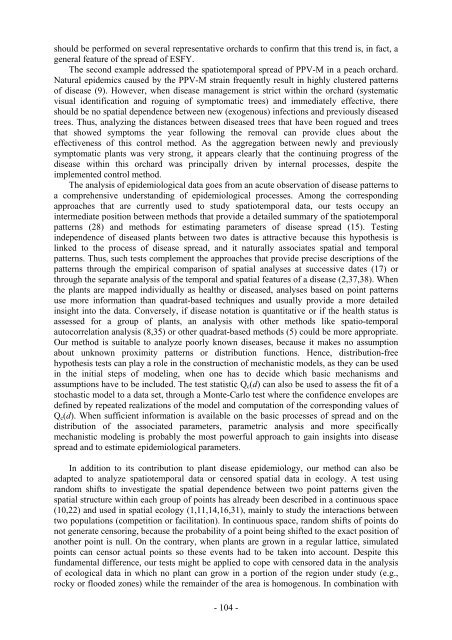Ecole Nationale Supérieure Agronomique de Montpellier ... - CIAM
Ecole Nationale Supérieure Agronomique de Montpellier ... - CIAM
Ecole Nationale Supérieure Agronomique de Montpellier ... - CIAM
You also want an ePaper? Increase the reach of your titles
YUMPU automatically turns print PDFs into web optimized ePapers that Google loves.
should be performed on several representative orchards to confirm that this trend is, in fact, a<br />
general feature of the spread of ESFY.<br />
The second example addressed the spatiotemporal spread of PPV-M in a peach orchard.<br />
Natural epi<strong>de</strong>mics caused by the PPV-M strain frequently result in highly clustered patterns<br />
of disease (9). However, when disease management is strict within the orchard (systematic<br />
visual i<strong>de</strong>ntification and roguing of symptomatic trees) and immediately effective, there<br />
should be no spatial <strong>de</strong>pen<strong>de</strong>nce between new (exogenous) infections and previously diseased<br />
trees. Thus, analyzing the distances between diseased trees that have been rogued and trees<br />
that showed symptoms the year following the removal can provi<strong>de</strong> clues about the<br />
effectiveness of this control method. As the aggregation between newly and previously<br />
symptomatic plants was very strong, it appears clearly that the continuing progress of the<br />
disease within this orchard was principally driven by internal processes, <strong>de</strong>spite the<br />
implemented control method.<br />
The analysis of epi<strong>de</strong>miological data goes from an acute observation of disease patterns to<br />
a comprehensive un<strong>de</strong>rstanding of epi<strong>de</strong>miological processes. Among the corresponding<br />
approaches that are currently used to study spatiotemporal data, our tests occupy an<br />
intermediate position between methods that provi<strong>de</strong> a <strong>de</strong>tailed summary of the spatiotemporal<br />
patterns (28) and methods for estimating parameters of disease spread (15). Testing<br />
in<strong>de</strong>pen<strong>de</strong>nce of diseased plants between two dates is attractive because this hypothesis is<br />
linked to the process of disease spread, and it naturally associates spatial and temporal<br />
patterns. Thus, such tests complement the approaches that provi<strong>de</strong> precise <strong>de</strong>scriptions of the<br />
patterns through the empirical comparison of spatial analyses at successive dates (17) or<br />
through the separate analysis of the temporal and spatial features of a disease (2,37,38). When<br />
the plants are mapped individually as healthy or diseased, analyses based on point patterns<br />
use more information than quadrat-based techniques and usually provi<strong>de</strong> a more <strong>de</strong>tailed<br />
insight into the data. Conversely, if disease notation is quantitative or if the health status is<br />
assessed for a group of plants, an analysis with other methods like spatio-temporal<br />
autocorrelation analysis (8,35) or other quadrat-based methods (5) could be more appropriate.<br />
Our method is suitable to analyze poorly known diseases, because it makes no assumption<br />
about unknown proximity patterns or distribution functions. Hence, distribution-free<br />
hypothesis tests can play a role in the construction of mechanistic mo<strong>de</strong>ls, as they can be used<br />
in the initial steps of mo<strong>de</strong>ling, when one has to <strong>de</strong>ci<strong>de</strong> which basic mechanisms and<br />
assumptions have to be inclu<strong>de</strong>d. The test statistic Qc(d) can also be used to assess the fit of a<br />
stochastic mo<strong>de</strong>l to a data set, through a Monte-Carlo test where the confi<strong>de</strong>nce envelopes are<br />
<strong>de</strong>fined by repeated realizations of the mo<strong>de</strong>l and computation of the corresponding values of<br />
Qc(d). When sufficient information is available on the basic processes of spread and on the<br />
distribution of the associated parameters, parametric analysis and more specifically<br />
mechanistic mo<strong>de</strong>ling is probably the most powerful approach to gain insights into disease<br />
spread and to estimate epi<strong>de</strong>miological parameters.<br />
In addition to its contribution to plant disease epi<strong>de</strong>miology, our method can also be<br />
adapted to analyze spatiotemporal data or censored spatial data in ecology. A test using<br />
random shifts to investigate the spatial <strong>de</strong>pen<strong>de</strong>nce between two point patterns given the<br />
spatial structure within each group of points has already been <strong>de</strong>scribed in a continuous space<br />
(10,22) and used in spatial ecology (1,11,14,16,31), mainly to study the interactions between<br />
two populations (competition or facilitation). In continuous space, random shifts of points do<br />
not generate censoring, because the probability of a point being shifted to the exact position of<br />
another point is null. On the contrary, when plants are grown in a regular lattice, simulated<br />
points can censor actual points so these events had to be taken into account. Despite this<br />
fundamental difference, our tests might be applied to cope with censored data in the analysis<br />
of ecological data in which no plant can grow in a portion of the region un<strong>de</strong>r study (e.g.,<br />
rocky or floo<strong>de</strong>d zones) while the remain<strong>de</strong>r of the area is homogenous. In combination with<br />
- 104 -



